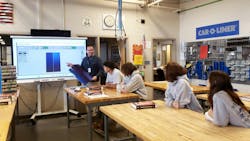Revolutionizing Collision Repair Training
A TechForce Foundation study suggests the U.S. will face a shortage of 642,000 automotive, diesel and collision technicians by 2024. Attracting young people to the industry and retaining new technicians remain critical challenges. If this shortage isn’t addressed, the collision repair industry could face severe delays, increased costs and an overall reduction in service quality. What can be done to address the issue?
It starts in the high school classrooms.
Schools recognize the evolving technology in the refinish industry and teach future technicians with up-to-date curricula. By equipping students with current technology, schools can better prepare them for success in the body shop. Empowering students with relevant knowledge will lead to a more skilled and confident workforce.
As the department head of Collision Repair Technology at H.C. Wilcox Technical High School in Meriden, Connecticut, we have transformed the education of color match and color theory for more than 50 high school students since the recent integration of PPG MagicBox virtual assistant and PPG Linq software last year. These innovative body shop tools connect technology to young groups of interested students seeking careers in collision repair. This type of technology is a quick study for most young students, who become natural users of these tools.
The Power of Digital Tools
Our approach leverages the latest technology to enhance the learning environment for tech-savvy students. Key tools include a virtual assistant for body shops, where a small device monitors the environmental conditions in the mixing room with sensors to automatically detect humidity, temperature, and pressure for the best results. The virtual assistant helps students adjust to real-world conditions, teaching them how to monitor environmental changes and adapt reducer selections in real time, making their work more efficient and precise.
We also use cloud-based digital color software that identifies the right color for a repair. These tools provide students access to digital color codes and mixing formulas, which prove essential for modern collision repair. The digital representations allow the students to compare accurate variants without mixing and spraying color yet thoroughly understand variant terminology. This is a new way of engaging and relevant instruction for students. Students must experience the innovation first-hand if we want to attract new technicians.
Hands-On Experience
Growing up in a digital world, today's students use technology naturally. We capitalize on this by making learning more interactive and relevant through these digital tools. The collision repair program at H.C. Wilcox follows the I-CAR curriculum for ProLevel 1 training. This ensures that the students receive hands-on experience with the latest technology, not just in refinishing but in structural and nonstructural repair and frame measurement. The program's integration of digital tools, such as the PPG MagicBox, means students learn theory while applying their knowledge in practical settings.
The four-year program has students spend half their time in the shop and half in academics annually. Body shops that hire our students consistently mention their readiness for real-world challenges.
Donations for Learning
It takes donations from the industry to offer this experience to high school students. This technology will provide students with hands-on experience in modern paint application techniques, helping them gain valuable expertise in an industry increasingly relying on innovation. By investing in this advanced tool, paint and coatings companies can enrich the educational curriculum and empower the next generation of skilled professionals to succeed in a competitive market.
Future Technicians
Body shop owners notice these advancements in technician training. They see the potential in hiring well-trained, tech-savvy graduates and strive not to fall behind. Shop owners constantly look for skilled technicians. By showing body shops the technology used in the program to train future technicians, we also help shops see the benefits of these tools in their operations.
As the collision repair industry continues to evolve, schools like H.C. Wilcox, supported by innovative companies like PPG, are paving the way for a future workforce equipped with both the skills and the technology to succeed.
About the Author
Bob Turcotte
Department Head, Collision Repair Technology Program
Bob Turcotte is the department head of the Collision Repair Technology program at H.C. Wilcox Technical School in Meriden, Connecticut, one of 18 Connecticut Technical High Schools where he has worked for 20 years. Before becoming an educator, he worked in the collision repair and engineering industries for 16 years.


